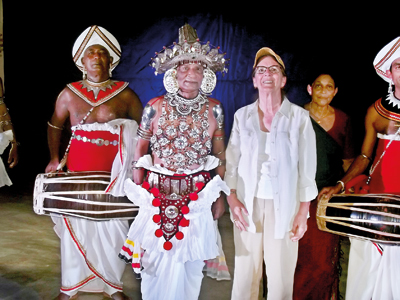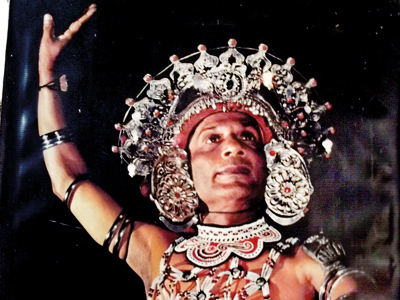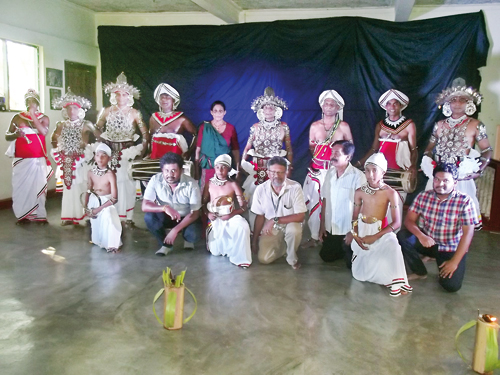A master laments the decline of Kandyan dance

Surasena with Prof. Wilkie
The famed dancer who has danced in 70 countries had an important visitor last week, one who had come all the way from the US. Professor Nancy Wilkie of the United States Committee of Blue Shield visited Peter Surasena and also met the four famous families of Kandyan dance and drumming: Tithapagala, Amunugama, Nitawela and Thalgahagoda.
They danced and drummed for her. The Professor had known Peter Surasena for several years and travelled to meet him several times. The US Committee of Blue Shield is focussed on protecting cultural heritage.
Surasena has not viewed the Kandy Esala Pageant for the past few years: though his feet feel the throb of the drums he cannot dance anymore at the age of 79. Having given his best to this art and danced in countries that the present day dancers would only dream of, he is now pondering the future of Kandyan dance.
So what is the future? Take out the dancers and drummers from the Kandy Esala perahera, it would be elephants, their keepers and the Nilames. In fact dancing and drumming is the core of the national pageant. Beyond this what is the future for these dancers who had given their life and time for an art for generations, he asks.
Surasena abhors the half baked donning of the “Ves” in schools, where the parents, he alleges, are fleeced, being asked to pay Rs. 100,000 for it. “Ves” in the past was donned only when a dancer had grasped all forms of the art and was a “master” dancer. It is only at that time, that “Ves” is placed on the head of a dancer.

Portrait of a Kandyan dancer:Peter Surasena
Surasena was initated into this art by the master Suramba Gurunanse. When he was in the eighth grade in a school in Wattapuluwe, he had told his mother that he wanted to learn dancing, because he yearned to go abroad.
One of a family of seven, with four brothers and three sisters, Surasena’s eldest brother is Heen Baba Dharmasiri and his master was N.M.Gunaya. After Heen Baba donned “Ves” he travelled abroad frequently as ambassadors arranged performances for these artistes to perform before an international audience.
It was no easy task to approach a “master” in this field as he would not part with his knowledge to one and all. His mother arranged to send him to the famous dancer Suramba, and he had to go with a Pingo of milk rice, oil sweets and what not. After he arrived at Suramba Gurunanse’s home, he was put to the test as to whether he would fit into the lifestyle of a dancer. In those days, the income was not enough for a dancer. Most of them lived on the land offered to them by the Sri Dalada Maligawa for performing in the rituals for the Sacred Tooth Relic.
The history of Kandyan Ves Dancing goes back to the time of King Panduwasdeva and the courtiers had to bring down performers from India to perform “ blessings” (Shanthi Karmaya) on the King, which ultimately turned into the Kohomba Kankariya. That is the foundation of Kandyan Dancing or dancing in the country, says Surasena. Whether there was dancing in the pre- Buddhist era in the country has yet to be found.
This festival of dance is mentioned in the “Kuveni Asana” – a Sinhalese composition from the Kotte period. According to Dr. Nandadeva Wijesekera, Kohomba Kankariya was performed for King Parakrama Bahu VI of Kotte in order to dispel enemies, and illness and bestow power, valour, long life and success on him.
Surasena says that the ‘Ves’ costume is a part of the costume of the King of Malaya and this was handed down to a selected group of persons, who are the four families of Amunugama, Tithapagala, Nittawela and Thalgahagoda. Whereever ‘ Ves’ is donned, it would be a pupil from these four families, he added. But today unfortunately, ‘Ves’ is given to schoolchildren who have just learned the basics of dancing, which brings “ Was” or the evil eye.

Four families of Kandyan dancers with the master
Surasena first participated in the Kandy Esala Perahera, as a ‘Udekki’ performer and then as a ‘Naiadi’ performer at the age of 12 years.
In 1959, when a State Dancing Troupe was formed, Surasena had not donned ‘Ves’ so Suramba Gurunanse decided then to “tie” Ves on him. ‘Ves’ was placed on him by Amunugama Suramba, Tithapagala Suramba and Nittawela Ukkuwa. This is a unique experience, where the four main Kandyan dancing family representatives had placed ‘Ves’ on one individual and it has not happened again.
Surasena’s first overseas performance was with the State ensemble to India – there were 17 performers, including six women artistes. Pani Bharatha led the troupe, Amaradeva was the vocalist and in the troupe was Vimala Amaradeva. He can never forget their performances in New York’s Carnegie Hall and London’s Albert Hall. It is a dream for any artiste to perform in these two theatres, he said, recalling that flowers were just flowing onto the stage after the performances.
President J.R.Jayewardene began the practice of offering commendations for Kandy Perahera performers and Surasena is proud to have received commendations from Presidents R.Premadasa, D.B.Wijetunge, Chandrika Kumaratunge and Mahinda Rajapaksa. He could not receive any award for his performances from President Maithripala Sirisena, as by the time he assumed office Surasena had fallen sick and had said goodbye to the stage.
But his three sons, Susantha, Janaka and Nilantha have performed several times together in the Kandy Esala Perahera – the homeground of Kandyan dancing.


